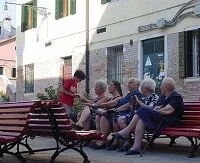Culture & Identity of Italy
Introduction

Relaxing
The Italians work to live and the daily way of life truly revolves around enjoying life, not work. However, work occupies much of their time and is needed to make the money wanted to enjoy life.
The way of life in Italy should begin with the weekends (Saturday-Sunday), evenings, and vacations, which are most often taken during the summer months when school is out. Life in Italy is social as people gather whenever they are given the chance. This may just mean dinner at home with the family or an extended vacation to the beaches or perhaps a ski trip to the Alps. Every Italian seems to love these times off and tends to fill these times with socialization, good food, and local Italian wines. For some, their Catholic faith is also important and Sunday is a day to attend church.
To have this relaxed lifestyle, the Italians work much like people throughout the world. Most people live and work in the cities, which is where nearly 70% of the population lives. The occupations are divided, but most working Italians have jobs in the services sector, with somewhat regular hours. For most people this means the workday begins at about 8:30 am and ends at about 7:00 pm. However, many people take a long lunch midday at home. Work seems to start late most Monday mornings and sometimes also cuts out early Thursday or Friday afternoons. However, for those people working in restaurants or bars the hours are vastly different as most restaurants only open at about 3:00 pm and many Italians eat late into the evening.